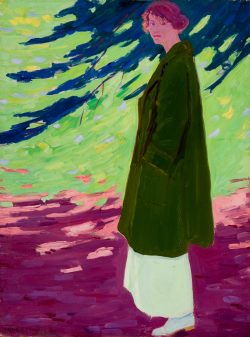Frederick Fursman, detail from a undated photograph of Fursman with Walter Marshall Clute and Edgar Rupprecht, courtesy Saugatuck Douglas Historical Society, Douglas, Michigan.

Frederick Fursman 1874–1943
Frederick Frary Fursman, a native of El Paso, Illinois, initially studied art at Smith’s Academy in Chicago and then attended the Art Institute of Chicago’s school intermittently between 1901 and 1906. His most influential teachers were John Vanderpoel, famed for his pedagogy in the drawing of the human figure, and John C. Johansen, an advocate for painting outdoors on site and with bravura brushwork. In these years, Fursman probably supported himself as an illustrator, but he also served as an instructor in both schools. In 1902 he made his debut in the Art Institute’s annual exhibition of American art. That year, he married Ida Luella Morton, a prominent educator whose active professional life gave Fursman the freedom to travel widely both to paint and to teach.
In 1906, the Fursmans traveled to Europe. Like many other American artists, the painter enrolled in the Académie Julian and spent summers painting the landscape and local life of the Brittany coast. Under Johansen’s continuing tutelage, Fursman worked in a broad manner, wielding a paint-laden brush but stopping short of the high-keyed colorism of impressionism. In 1909, the last year of his sojourn in France, Fursman had two of his paintings accepted into the Paris Salon exhibition, and on his return to Chicago the Art Institute hosted an exhibition of his French works.
Fursman soon made a place for himself within Chicago’s varied cultural community. In 1910 he became an instructor in the Wisconsin School of Art (now part of the University of Wisconsin–Milwaukee), dividing his week between Milwaukee and Chicago. That year he also began his long association with the Summer School of Painting at Saugatuck, in Michigan, begun in 1898 by Johansen and John W. Norton. Fursman shared administration of the school with painter Walter Marshall Clute until the latter’s death in 1914. Until the end of his life Fursman remained a director of the program, which was renamed Ox-Bow and affiliated with the Art Institute’s school. He was also a highly popular teacher who counted Arthur K. Houlberg and Edgar Rupprecht among his students at Saugatuck. In 1914–1915, Fursman briefly ran his own school in the Tower Building in Chicago, and in the 1920s he was a visiting instructor in or director of art schools in Kentucky, Colorado, and Winnipeg, Canada.
Throughout his career, Fursman was an active exhibitor at the Art Institute and other regional venues. In the 1900s and 1910s he focused on the figure posed outdoors in bright sunlight, creating paintings that echoed the formal concerns of European modernist artists in their expressive color, patterned effects, and decorative brushwork. His experimentation reached a new level during his second trip to France, in 1913, and in his work in Saugatuck in the following half-decade. Later, Fursman began making powerful portraits of working-class individuals, figure studies, and small, rapidly painted landscapes of scenery in the American West. Fursman’s importance was recognized with his inclusion in such major exhibitions as the Art Institute’s Century of Progress loan exhibition in 1933 and “Half a Century of American Art” survey show in 1939–1940. At his death in 1943, however, Fursman was remembered more as an influential teacher than as a progressive artistic practitioner.
Wendy Greenhouse, PhD
